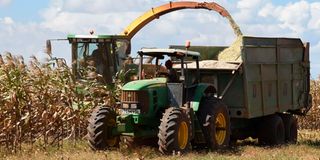Worrying scramble for maize between humans and animals

A farmer in Sergoit, Uasin Gishu County, harvests maize for silage in 2020. Many farmers have embraced the feed, raising competition for maize between humans and livestock.
The ongoing drought is ravaging the rangelands causing untold suffering to both humans and livestock. Grotesque pictures of livestock carcasses strewn in the once-lush pasture grounds of the arid and semi-arid lands (Asals) are a common feature in the print, broadcast and social media.
The full impact of the drought was hidden by the just-concluded political activities. But the severity of the situation is now evident. Something is really not right with the nation’s preparedness for and management of natural calamities.
I recall a discussion I had with one relief worker on a flight from Turkana a few years back. He told me he was shocked to see people sorting out beans from a food ration his organisation had supplied. The people ate the beans and gave the maize to the cattle. He did not understand the rationale.
My explanation was that the animal owners were fair-hearted. They could not eat alone while their animals starved. They also understood the beans were not good for the cattle but were harmless to humans.
Scarce food resources
The case was an extreme form of humans competing with livestock for the same scarce food resources. Unfortunately, that is what has been happening in the country even in apparent periods of plenty. It is one of the reasons why there is food scarcity.
The main and bulk staple food for Kenya is the famous ugali and githeri (mixture of maize and beans). These are both products of maize. For the food items to be produced, maize must be grown to full maturity and the grains harvested. The left-over dry maize plant, called stover, is depleted of nutrients and is unfit for feeding livestock.
The harvested maize is milled for human food and only the residues such as maize germ and bran are available for livestock feeds. The residues are expensive and in short supply. This makes factory feeds unaffordable to most farmers. It is one of the reasons why Kenyan livestock are in a state of perennial malnutrition.
In countries where the livestock industry thrives like the US, Canada and Europe, maize is mainly used for production of animal feeds as whole grain or the nutritious immature maize is processed into silage. Humans depend more on other crops like wheat, oats, rice and potatoes for their food.
High quality grass
Kenya must realise that the country has utilised most of the high quality grass producing areas for human settlement and production of maize for human consumption. This has left livestock with very little room for survival. But all is not lost. There is still room to make amends. In future articles, I will share emerging ways of how Kenya can address the human-livestock scramble for the scarce maize.
First, let me put into perspective the livestock industry in Kenya as compared to the rest of Africa and the human population. This will shed some light on the food scramble. I have reviewed data from various authoritative sources including Kenya Census 2019, the Economic Survey 2021 and FAOSTAT. The latter is an agricultural data repository of the Food and Agriculture Organisation of the United Nations (FAO).
The livestock industry is one of the key economic pillars of the Kenyan economy valued at approximately Sh1.3 trillion. It contributes about 12 percent of the nation’s gross domestic product (GDP) and nearly 42 percent of the GDP in agriculture. GDP is the most commonly used measure for the size of an economy.
The livestock GDP, ranked as a country in Africa, would take the 33rd position being ahead of 20 real nations, including Namibia, Rwanda, Malawi and Somalia. This favourable comparison underpins the value and importance of the livestock industry to the Kenyan economy.
36 million goats
In 2020, Kenya had 21.6 million head of cattle, 36 million goats, 25.3 million sheep, 4.7 million camels, 57.1 million chicken, 0.73 million rabbits and 0.5 million pigs. This comprises 146 million animals all angling for the same maize with about 54 million Kenyans at the time.
About 45 per cent of the Kenyan cattle are held in the seven Asal counties of Mandera, Wajir, West Pokot, Turkana, Baringo, Garissa and Narok. With the addition of Samburu, Marsabit, Isiolo and Laikipia, these areas have 74 per cent and 70 per cent of the sheep and goat population respectively. Except for Narok and Laikipia, very little or no maize is grown in these areas of high livestock concentration.
The good thing is that livestock in the Asals are mainly grass fed. However, in times of adversity, they require supplementation with the scarce maize products. This requirement is set to escalate as more farmers in these regions embrace commercial feedlot farming where maize is a core ingredient of the animal diet.
A constant competition for maize between humans and livestock exists in the high rainfall counties of Central Kenya comprising Kiambu, Murang’a, Nyandarua and Nyeri. These areas have large numbers of exotic cattle under the zero-grazing system. Maize-based commercial feeds are used routinely in large quantities. Yet, maize production in the region is highly limited by the small size of farms.
The maize competition in the central region is further raised by the heavy farming of chickens and pigs that predominantly grow on commercial feeds.





